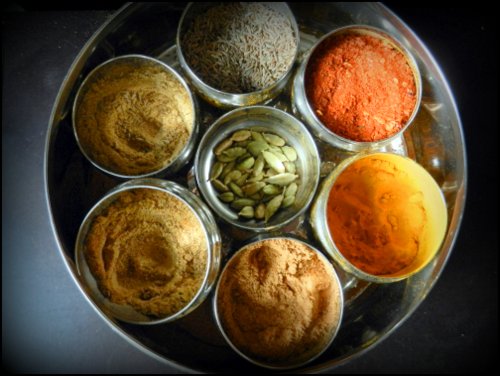
Last week I spoke with Indian Food Blogger, Jahnavi, of Indian Khana Made Easy, and we got into the nitty gritty details of Indian cooking – namely, Indian spices. The magic of Indian food is in the tiffin. How you blend spices into masalas for chicken, lentils, or vegetables; how you layer spices to give heat or round out a flavor; how you infuse oil with spices instead of adding them directly to the cooking pot. Here’s what Jahnavi had to say – and while I have my own tiffin (and know how to use it), I learned more than one surprising fact.
“Different cultures use seasoning differently.” – Jahnavi, Indian Khana Made Easy
Curry – The first thing we talked about, as you might guess, was curry. “In the U.S. when you say ‘curry’ to someone, they think of the yellow powder. But curry is the whole vegetable dish with the spice mixture. Curry powder was introduced by the British because when they saw how many spices are used in Indian cooking, they decided to blend them together and simplify it.”
Essentially, “Curry” as we know it was the first wave of British-Indian fusion – also, Chicken Tikka Masala (invented by a Scotsman).
Garam Masala – the most common Indian masala – is made up of black and white peppercorns, cloves, cinnamon, black and white cumin seeds, and black, brown, and green cardamom pods. I knew it tasted good, but Jahnavi taught me a different perspective on its flavor – the concept of “heat,” which means something different in India than it does in the U.S.
“In English, Garam Masala is a spice blend that gives heat to a dish, but not necessarily spicy-hot. There’s a difference between spicy-hot and giving heat to a dish. When you’re eating biryani, or a vegetable dish that uses garam masala, it feels warm in your throat as you’re eating it. That’s what Garam Masala does.”
And here I thought that it was only Indian food if I was crying in pleasure/pain by the second mouth-full.
Garam Masala is very North Indian, which makes sense because it’s colder in the North. South India, Jahnavi tells me, has food that uses less spice and more ingredients considered cooling, like coconut.
Secrets of Seasoning – Another trick I learned was to infuse oil with spices first, then toss the main ingredients in the seasoned oil. Jhanavi says, “When you infuse oil with spices, it intensifies the flavor. So you heat the oil, add your spices, then add your plain basmati rice and saute it with the oil and spices, and then add it to the rice cooker to cook. Or when we make lentils, we cook the lentils with curry leaves, salt and pepper, then we heat the oil and season it with cumin and mustard. Then we stir in that flavored oil with the lentils at the very end. When you add it at the end, you give it a heated flavor; it gives it some kick.”
For a complete explanation all the major Indian spices – check out Indian Khana Made Easy’s Spice Rack section.